By Claire Bacon, ACN, CNC
I feel like I have been writing this post in my head for years. Ever since I entered perimenopause (and beyond), I have been obsessed with hormones. I’ve continually been learning more about our collective sex hormones and what each one does, and how they affect each other. As soon as I feel I have a concept down, that leads to another question and another deep dive. The estrogen rabbit hole is particularly deep. You may think you know what estrogen does, but I promise you, most people have a very rudimentary understanding of estrogen’s effects in the body.
First, let’s get the fundamentals down…
Estrogen is the dominant feminine hormone that flows through the body from puberty to menopause. It supports just about every major system and tissue in the body, as we will detail below. Of the three types (E1, E2, and E3), E2 or Estradiol plays the dominant role in breast development, menstrual cycles, ovulation, bone turnover, metabolism, and even brain remodeling.
Estrone (E1) is created by our fat cells and becomes our dominant estrogen in the post-menopausal phase. High Estrone can be a result of inflammatory changes in the body, so it’s good to keep an eye on this one. If we can keep our weight under control, that’s a good sign Estrone is under control, too. Estriol (E3) is the typical estrogen that is high during pregnancy. It’s a weaker estrogen that doesn’t have as many benefits as Estradiol, but it can be helpful to ease the low-estrogen symptoms of menopause. E3 can help with vaginal dryness, hot flashes, and night sweats, but probably will not give other desired benefits for cognition and bone health.
Getting started, not overwhelmed
Although we will not forget that men have estrogen, too, this article will serve as a summary of all the important points that peri- and post-menopausal women need to consider as hormones decline. Believe me, there is so much to wrap your mind around! You’ll want to start learning early so you know what to expect!
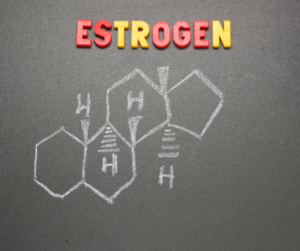
Hot Flashes and Night Sweats
Otherwise known as vasomotor symptoms, hot flashes and night sweats are the best known side effects of the menopausal hormone decline. They can really get your attention! For some, these uncomfortable changes in temperature control might be the first sign that estrogen is not where it once was. Why does this happen? Experts have many differing opinions, but it seems to be:
- The drop in estrogen triggers changes in blood vessels, with erratic widening and constricting.
- Our internal thermostat can’t maintain our temperature properly without a consistent supply of estrogen.
- The hypothalamus, pituitary, and thyroid experience impaired signaling with each other without sufficient estrogen.
- Our core body temperature increases both randomly and with changes in stress.
- Sugar and alcohol can no longer be tolerated without triggering temperature changes.
- We may experience debilitating heart palpitations, too. Any mid-life woman with AFIB should check her hormones!
The list of symptoms related to vasomotor function goes on and on!

Estrogen and the Musculoskeletal System
There may come a point right around menopause when your bones and joints just don’t feel the same. Maybe you’ve been doing exactly what we recommend by hitting the gym – but suddenly you’re having an odd elbow pain with the lightest weight. Or it could be a deep ache in your hips. Even more common, you could suddenly realize that your shoulder is “frozen” and you can’t lift it above a 90 degree angle! Guess what – this is not simply a musculoskeletal issue. You can get adjusted and massaged all you want, but you’re not going to find 100% relief until you fix your hormones.
Something quite odd that happened to me was an enlargement of my left elbow right after turning 51. It literally grew and stuck out like Popeye! I was fascinated by what was happening, and terrified at the same time whether I had some odd degenerative disease. Nope! Nothing serious like that. Once I checked in with some hormone testing and took action to balance things out, my elbow went right back to normal. Amazing!

Bone Elasticity is the Key
Here’s the point I want to make: estrogen is vitally important for our bone health. That’s because it plays a regulatory role in how our osteoblasts, osteoclasts, and osteocytes work. These are specialized cells that control cellular growth in the bones, as well as the turnover and resorption of old cells as they die off. Without the beneficial influence of estrogen, we tend to not build new cells as fast, and we start losing the good cells we have faster.
Estrogen provides a direct stimulus to the cells that give our bones a degree of elasticity and flexibility. Let’s say, if we take one of the popular bone pharmaceuticals, we’ll gain a benefit in not losing our bone cells so quickly. But we won’t gain anything in the way of elasticity and flexibility. Our bones become stronger and more dense, but also more brittle. As in, easier to shatter. That’s why in our opinion, it’s a better strategy to increase our weight lifting to provide the cellular growth stimulus that estrogen used to provide.
Estrogen is not the only thing
In addition, we want to optimize our nutritional support for bone health. And it’s best to get exogenous estrogen (HRT) on board early. All hormones need optimization: everything you can test and figure out, like estrogen, progesterone, testosterone, DHEA, cortisol, insulin, melatonin, and thyroid hormones. It is a complex relationship, but you can bet that it is all related.
On top of all that, weight lifting with heavy weights (not baby pink dumbbells) is the key to make the magic happen. I don’t care who you are, you really can’t miss this important step. Weight lifting needs to be your new #1 hobby. Embrace it!
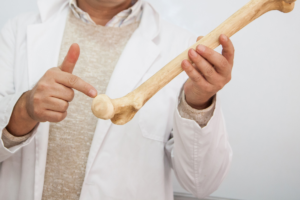
Cardiovascular Health
Estrogen is well known for keeping your heart healthy. How does it do that? Recent studies show that estrogen:
- Increases HDL cholesterol and decreases LDL cholesterol, keeping our lipids balanced nicely.
- Relaxes and dilates blood vessels to improve circulation.
- Neutralizes free radicals, which are byproducts of aging and oxidative stress that can damage your arteries.
The most well-known hormone/cardiovascular risk study in history is the Women’s Health Initiative (WHI), which began in 1998 and ended prematurely in 2002. The study’s results were re-reviewed in 2022-2023, and women’s health experts have been up in arms ever since. During the WHI, the hormone therapy used was an oral conjugated equine estrogen (CEE) alone compared with oral CEE together with oral medroxyprogesterone acetate (MPA). Note that these forms of hormones are no longer typically used in practice.
In a nutshell, the main problem is that the WHI used only one type of oral hormone therapy, yet the results were applied to ALL types of MHT, which have different doses and routes of administration. In addition, the media ran with the most alarming headlines, neglecting to report accurate data, and the lead scientists had no opportunity to provide necessary clarifications. As a result, the vast majority of women stopped their hormone therapy, and doctors and the public alike have been fearful of using estrogen ever since.
What we’ve learned since the WHI…
However, at this time we can see multiple truths:
- Bioidentical hormones that match our naturally-produced hormones have a better safety profile than oral synthetic hormones (like the ones in birth control pills).
- Micronized bioidentical progesterone is safer than synthetic progestin. Micronized progesterone can be oral or topical.
- Estrogen/Progesterone therapy started earlier in menopause provides greater cardiovascular benefits.
- When started beyond 10 years post-menopause, Estrogen/Progesterone therapy does not give as strong of benefits compared to earlier. Note: this does not mean you cannot start E/P therapy later in life.
- Stopping E/P therapy later in life allows for further decline in cardiovascular and bone health. In other words, to maintain the benefits from E/P therapy, we must continue doing E/P therapy.
There is sooo much to learn and understand about the complexities of different kinds of hormone replacement. If you’re ready to overcome your fears and get started learning, please check out the resources I’ve compiled here for you.
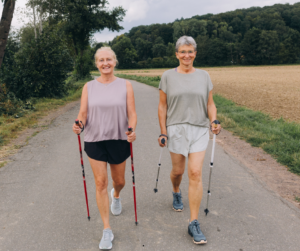
Estrogen Protects Brain Health and Cognitive Function
We all have moments when we can remember why we went into a certain room. And we all have moments when certain words or names escape us. That doesn’t mean we’re coming down with early onset Dementia. But it could mean we’re low in estrogen.
In 2024, Dr. Lisa Mosconi published her book, The Menopause Brain, on estrogen and brain health that exploded her into notoriety. She explains how the loss of estrogen influences everything from body temperature to mood to memory, setting us up for cognitive decline later in life.
Physical changes due to Estrogen loss
Dr. Mosconi’s 15+ years of research highlight the fact that estrogen receptors in the brain actually change energy production and the volume of gray matter at different phases in life. There is a definite restructuring that happens at puberty, another at pregnancy, and yet again at perimenopause. These are functional changes that are visible on brain scans, and they happen for a reason. The changes heighten certain skill sets, emotions, and physiology according to different life needs. The transition process can invoke hormonal fluctuations, which in turn can create symptoms like brain fog. This is not a disease, and it’s not early dementia. It’s brain repatterning, a normal and expected function of our physiology.
I highly recommend that every woman read Dr. Mosconi’s book. And all our male partners, friends, and brothers need to read it too. If only more husbands could understand why women change through life, they could experience greater understanding and compassion. With more understanding, our relationships would deepen, intimacy could continue longer through life, and I have no doubt we’d reduce the occurrence of mid-life divorce.

Eye Health and Ocular Function
We know that the small blood vessels in the eyes are extremely vulnerable to changes in inflammation. These tiny capillaries dilate and constrict just like their larger counterparts, the veins and arteries. Estrogen and its balancing counterpart, Progesterone, have a beneficial effect on the normal relaxation and constriction of our capillaries. E and P also help with the lubrication of the mucus membranes (i.e. can prevent dryness). So, if you’ve been reaching for your reading glasses more often, this may be a clue your hormones need some help.
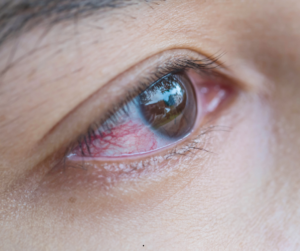
Bladder and Urinary Health
Oh. My. Gosh. This connection is so misunderstood, and not talked about nearly enough!
Our bladder is so highly influenced by things within our control. Yes, we can improve our bladder function and reduce urination leakage and frequency, naturally! Pelvic floor exercises help with muscle strength. Reducing sugar, alcohol, and carbohydrates in the diet improve the nerve functioning and signaling between the bladder and the brain. Increasing hydration and flushing out toxicity all day can help your nighttime situation get better, too. And the cherry on top is ESTROGEN.
Estrogen has a surprisingly positive influence on keeping the bladder wall happy, healthy, strong, not irritated, and functional. That’s why vaginal estrogen is so beneficial – it not only protects the wall of the vagina, but it absorbs into the bladder wall, too. This keeps it youthful with a functional immune system, and prevents the most widespread scourge of nursing homes: the genito-urinary syndrome of menopause (GSM).
The epidemic of GSM
GSM is likely to be the most common chronic illness affecting elderly ladies, with potentially devastating effects. This is a syndrome of frequent and chronic urinary tract infections, which can cause severe pain, with chronic symptoms that go on for years. Many women wind up taking a low dose antibiotic, which keeps bad bacteria down but also destroys our beneficial microbes. And it does nothing for yeast! Combine that with a high-carb diet that most elderly are on, and you’ve got a recipe for disaster: continued pain, embarrassment, and aggravation. Not to mention an increased risk for a deep infection that can kill you.
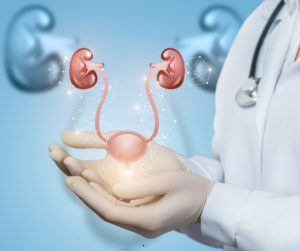
Estrogen is the Remedy for Vaginal Dryness and Atrophy
Vaginal dryness is probably the most obvious deficiency symptom you can have, when your estrogen levels drop. Suddenly, the intimacy that motivated and deepened our relationship becomes painful. Without a good remedy, we can become fearful and start avoiding sexual activity. It’s our misunderstanding of what to expect and how to deal with vaginal changes that can eventually take a toll on our psyche. We may start rationalizing why we don’t need sex. Why would we want it? If it’s not enjoyable and there’s no pleasurable reward, we mentally will start downplaying any reason for it in the first place.
But we CAN get it back. And there are physical and emotional benefits to doing so. Vaginal estrogen is cheap and easy to use, and readily available if you know where to look. And as more and more medical doctors get back on board, it will become easier to support ourselves as soon as we need it.
Getting back our vaginal pleasure
However, so many women are so scared of using estrogen that they won’t even consider it. The fear of worsening breast cancer risk dramatically overshadows the desire to… have more desire. Yet, the main reason for this is just an after-effect of the misinformation that followed the Women’s Health Initiative (WHI) study. (Check out the links in the Cardiovascular section above).
Vaginal estrogen is safe for every woman to use. Whether you have had breast cancer in the past or not, vaginal estrogen stays in the vagina. It does not go systemic. This delivery method benefits the vaginal tissues, cervix and clitoris so much, that they hold it right there. It doesn’t go anywhere else, and does not increase your breast cancer risk. Rather, it greatly reduces the risks for multiple uro-genital conditions:
- vulvar atrophy, where the exterior vaginal tissues become thin and friable,
- clitoral adhesions, where the skin permanently sticks to the clitoris, causing pain,
- lichen sclerosis, an autoimmune condition that shows up as white streaks across the formerly pink tissues, and
- labia minora that disappear into non-existence. WHAT?!?!
None of us want ANY of those things to happen. And they don’t need to, because we can protect ourselves with estrogen (along with many herbs containing natural phytoestrogens).
Non-hormonal vaginal remedies
In addition to an estrogen tablet and estrogen cream, there are some good non-hormonal remedies, too. Bezwecken offers the Renewed suppositories, which provide DHEA with Frankincense and Calendula diluted in cocoa butter. We provide these in the office, along with their light bioidentical options for topical and vaginal use. I can personally recommend the Joylux vFIT Gold+ red light therapy device, used together with hyaluronic acid. In addition, there is a Tildalafil/Sildenafil prescription cream (from your doctor) that helps the vulvar tissue with microcirculation and sensation.

Metabolism and Insulin Resistance
Estrogen has a beneficial influence on your ability to stay lean. It helps your insulin receptors work properly to control your glucose levels. Now, there’s nothing wrong with Grandma getting a little more plump in her older age. My fondest memories of my own Nana were her loving hugs, complete with her “pillows” smashing into my and my sister’s faces. Younger, thinner women can’t give hugs like that! But maybe we’re just not ready to give up our girlish figures just yet.
Recent studies are exploring the ways that estrogen supports our insulin receptors. By this mechanism, estrogen deficiency leads to a quick shift in our metabolic efficiency. We are seeing that women who use HRT enjoy metabolic benefits from E2, with better energy, better glucose metabolism, and can better control their weight. Certainly, this is one of the top health benefits older women are looking for!
Do cats get hot flashes?
For example, this is one of the key differences I’ve noticed between my three cats. “Do Cats Get Hot Flashes?” will be the title of my future book, I’m sure. Let me explain…
The two older ones had their spay right around the six-month mark, which similar to women, causes an immediate surgical menopause. However, my youngest cat, at three years old, is still intact. I just haven’t had the motivation to alter her hormones in that way. My curiosity to watch the differences in their metabolic health and personalities still outweighs the inconvenience of dealing with her periodic heats. Anyway, after three years of watching this experiment, Chloe’s intact hormones have kept her more energetic and playful and much more thin and metabolically fit than her menopausal counterparts.
It makes me wonder, if my cats exhibit different abilities to gain or maintain their weight (while eating the same foods) can we make the same comparisons to women with similar changes in their hormonal profiles?
It’s an interesting comparison that I’m still watching and learning from. And I’ll be documenting any changes along the way!
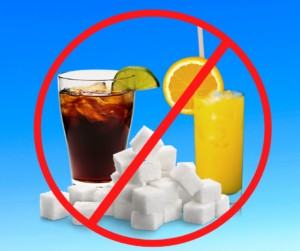
Estrogen’s Influence on the Microbiome and Gut Health
Estrogen even works deep within your gut, on keeping a good balance between all the microorganisms living there. This may be the biggest unanswered need for menopausal women, as it’s the least obvious when we need help. We just aren’t informed enough to make this connection. You may have noticed more bloating in your gut, either with or without digestive symptoms. Or, you may be having an odd odor or vaginal discharge.
With the loss of estrogen, this is a modulatory mechanism that loses function. And it shows up with a gradual loss of the beneficial bacteria that should be in the intestines and the vaginal environment. We need multiple strains of Lactobacillus and Bifidobacterium, with F. Prauznitzii and Akkermansia, and Bacillus strains for good diversity. Without these strains, we lose our natural ability to stay lean, energetic, and with good immune function. We also will have more trouble with producing calming neurotransmitters like serotonin, GABA, and dopamine that keep us calm and happy.
Certainly, our healthy gut bacteria give us benefits in many ways!
Gut testing for flora imbalance
Remember, we can do a GI-Map stool analysis or a Biome FX vaginal flora analysis. The DUTCH test even includes the marker for Indican, a gut dysbiosis marker. Any of these gut-related tests (that we often do for other reasons) could point to a need for hormone balance. The more detailed our data, the more we can know which beneficial bacteria to add in, to help with weight loss or other menopausal issues.
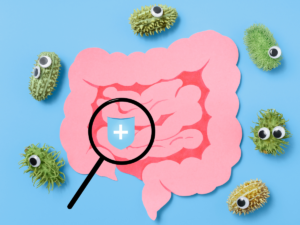
But what if my MHT isn’t working?
If your Menopausal Hormone Therapy isn’t working, there must be a reason, and you have to figure it out. Don’t give up!
- Progesterone and other steroid hormones are fat-soluble. To be absorbed, they need proper bile acids and pancreatic lipase formation. If fat digestion is sluggish (low bile flow, low lipase, sluggish pancreas), absorption of oral hormone supplements can be significantly reduced.
- Gut dysbiosis (imbalanced microbiome) can compound the problem:
- Alters bile acid recycling → less efficient fat digestion.
- Increases inflammation and gut permeability → less stable absorption environment.
- Reduces hormone recycling (via β-glucuronidase imbalance) → more hormones get excreted instead of re-entering circulation.
- The result: You can swallow the same dose every day but see falling blood levels, because the body simply isn’t handling and absorbing those hormones effectively.
So yes — if someone has fat digestion issues and a dysbiotic gut, it can explain why exogenous hormones “don’t stick” or don’t yield the expected clinical response.
👉 That’s why in Functional Nutrition we often support bile flow (ox bile, bitters, taurine), enzymes (lipase and others), microbiome balance, and gut repair before or alongside hormone replacement. Otherwise, it’s like pouring water into a leaky bucket.

And lastly, let’s discuss the most outwardly obvious benefits of estrogen…
Skin, Epithelial Tissue and Collagen Formation
It’s a normal and expected fact that we will develop wrinkles as we age. But we still want to resist! The multi-billion dollar Botox and anti-aging cosmetic industries are proof of this. Not only do we believe we can slow the effects of aging, we spend loads of money on products claiming to enhance our beauty. Billions!
Maybe we could be more intelligent with the money we spend on our skincare. After all, the majority of these products are loaded with parabens, fragrances, and harmful preservatives that can impact our health.
Estrogen supports collagen utilization
Estrogen has a beneficial effect on the way our body utilizes collagen in the body. It influences skin elasticity, moisture levels, and overall vibrancy. Estrogen stimulates more collagen to be formed, and over time can have a visible effect. That’s why many anti-aging creams may contain a small amount of estrogen. Below a certain threshold, the FDA allows minimal levels of estrogen in products without being disclosed on the label. So sneaky! This can make a product more effective for an older lady, but could add up to excessively high levels in younger women.
One of our favorite nutritional products in the office is Biotics Optimal Collagen. It provides five different types of collagen, combined with bioactive silicon. These ingredients are suited to all the different needs for collagen in the body, whether for use in skin, bone, or connective tissue like fascia, ligaments, or tendons. It’s a wonderful foundational support to keep our hair, skin, and nails healthy as we age.
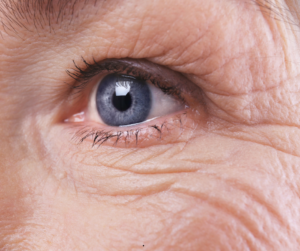
Best Foods for Estrogen Support
Yes of course, there are many foods and supplements that can help support your natural hormone levels without adding in an exogenous estrogen. These are foods that are potent in “phytoestrogens”, or plant chemicals that have hormonal benefits. For instance, for cycling women we often recommend ground flax seeds with raw pumpkin seeds in the follicular phase, followed by ground sesame seeds with sunflower seeds in the luteal phase. For menopausal women, you’ll enjoy having more non-GMO, organic soy and edamame, with ground flax seed for fiber, Udo’s 3-6-9, or different flavors of Barlean’s oil. You’ll want to check out this list of Best Foods for Phytoestrogen Content.
And be sure to visit Dr. Mosconi’s recommendations for healthy beverages, breakfast, dinner, and even desserts that support your estrogen and brain health.

Becoming an Advocate for Your Health
As you start noticing changes about your body, you’ll need to start gathering information with testing. With your results, while considering what form of hormonal support you might need, you’ll need to draw on all your new education to make a good decision. How will you get started? We suggest you start with reading this blog, and then making a personalized Nutrition appointment for a targeted discussion. Then you will be armed with complimentary information and a frame of reference for when you next see your medical doctor.
You never want to make a decision out of fear. If you’re feeling fearful, that’s a sign you don’t have all the information you need. And that’s your queue to take a step back, logically consider all options, and listen to your heart.
When you’re optimizing your hormones, monitoring regularly, and doing all the right things with diet and exercise, you can be confident you’re preparing for your best possible future ahead!



